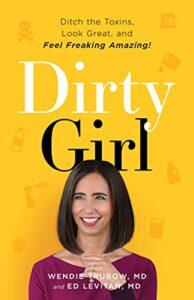FLEETSTREET is thrilled to offer this excerpt about how to stop dieting from Dirty Girl: Ditch the Toxins, Look Great and Feel Freaking Amazing, by Dr. Wendie Trubow, MD.
By the time Emily made it to us, she was sick as sh*t! At just over 30 years old, this once vibrant, energetic and brilliant young woman sitting in our office was a shell of a human being.
The medical history provided by her primary care doctor said her symptoms began about three years prior. What started out as headaches and the desire for a nap in the afternoon had grown to the need to sleep more hours of the day than she was awake. And now it didn’t make much difference whether Emily was horizontal and conked out or upright with eyes wide open: She had very little motivation to do anything and was emotionally distant.
What is auric living? How do you know if you’re doing it right?
It was explained to us that she and her husband worked for a startup that had hit the ground running. On top of being crazy busy getting their company cranking, they had purchased their first home, which piled on to her responsibilities. So, when the desire for a nap originally hit in the afternoons, it seemed natural. Who wouldn’t be tired with all Emily had going on? Knowing she was overextended energy-wise, she indulged the naps. But then their lengths grew – even after she started going to bed earlier and waking up later – and yet she never felt she was getting enough sleep.
Soon, it became apparent that her memory was slipping. And as lethargy replaced her alertness, she lost the ability to think clearly. She also lost the ability to do math, which for some of us might not seem all that important, but not only was she typically good at math, she needed it for her business! She needed to function in general and just couldn’t.
Eventually, the perpetual state of brain fog became so dense that no lighthouse on the Eastern Seaboard could penetrate it. She needed help!
Since she was referred to us from her primary care doctor, we knew she’d had the basic blood work and testing done, so we skipped ahead and ran a series of toxicology tests. Sure enough, her body was loaded with lead. In fact, she had the highest level of lead toxicity we had ever seen. Her husband had a high level too, which helped us figure out the source. It had to be from a place they both frequented and someplace new to them when the symptoms began. In other words, it had to be from their new-to-them home, which was old enough to have lead pipes in the plumbing.
How to get sleep when you can’t and say goodbye to sleepless nights.
When we do heavy metals testing (lead and mercury, for example), we like to see levels under eight. Anything over eight gets our attention. Sixteen or above is considered significant. Sometimes, we get people (particularly older people who have been exposed for longer periods of time) who are in the 30-to-50 range, occasionally as high as between 70 and 80. However, this patient’s number was at 120—15 times what we believe is the highest acceptable amount!
Thankfully, with a solid detoxification program, Emily slowly came back to her old self. It took about a year – and some new plumbing and renovation in her home – but her brain fog has cleared. Once more, she’s energetic, she’s mentally astute, and she’s awake enough every night to watch the 11 o’clock news (though we discourage everyone from watching the news before bed; the combination of stress and blue light is not a recipe for good sleep).
Before you start thinking Emily is a rare case, know that according to the CDC, there are 15.8 cases of lead poisoning per every 100,000 working adults. Note: “100,000 working adults” means per 100,000 people working in companies that do blood lead testing as part of their OSHA requirements in states where it’s mandated. In other words, the actual prevalence is most likely much higher.
And that’s for lead poisoning. Now, as far as body burden goes, perhaps first we need to put a word in here that differentiates between poisoning and toxicity. The difference is that poisonings are often from overexposure within a short period of time, and the body is flooded beyond its ability to keep up and remove the toxins. The kids in Flint, Michigan, have lead poisoning from their bad water. Their bodies literally cannot deal with the lead that they have been exposed to, and they are extremely ill as a result of it. Most of us, as adults, do not have lead poisoning. We have an elevated toxic burden—an elevated burden that stresses the whole body. That’s the kind of people we deal with, the ones who have toxicities, not poisonings, and as you’ll discover in Chapter 7, we do different kinds of testing to determine the toxic burden in our bodies.
But while lead is a serious contaminant in many people’s water, it’s not the only potential toxin we are unknowingly drinking.
Destination run? Increasing intensity? Thinking about exercising in the heat? You should read this.
Tainted water and shameful food
Let’s face it. Our “clean” drinking water ain’t so clean. Plenty of other industrial chemicals are keeping company with each other inside that perfectly clear liquid running from your taps. Here are just a few of the main culprits that could be wreaking havoc in our bodies.
Fluoride
“Look, Mom—no cavities!” That slogan was made famous in ads designed by Norman Rockwell for fluoride-enriched tooth- paste back in the 1950s. But not everything about fluoride is so happy and positive. In fact, several countries, including Sweden, Germany, and Switzerland, have stopped putting fluoride in drinking water because it was deemed more harmful than beneficial.
I know what you’re thinking! But we need fluoride for healthy teeth! That’s what we are constantly told. I’m not going to go “there” with fluoride. But I will tell you no one should be ingesting it. First, do you know where the fluoride in our water comes from? Industrial sludge! Wonder what a Rockwell painting of that would look like!
The fluoride in our drinking water is actually an industrial by-product, which is a fancier term than sludge; it’s an unprocessed leftover from fertilizer manufacturing. Right. Fertilizer. It’s not good enough to be fertilizer, yet it’s supposed to be good enough to go in our water.
But it’s not. In fact, it’s very, very bad for us. It’s been associated with cognitive decline, hyperthyroidism, and poor absorption of magnesium, calcium, and potassium, among other nutri- ents, and “population-based-studies strongly suggest that chronic fluoride ingestion is a possible cause of uterine cancer and bladder cancer; there may be a link with osteosarcoma.”
Vitamin D is the one supplement every woman needs. Here’s why!
Mercury
Liquid mercury is a neurotoxin. It’s also extraordinarily beautiful to look at. That’s why I was playing with it back in high school. A thermometer broke, and beautiful balls of the silvery liquid bounced around. I just couldn’t resist playing with them. They felt heavy and liquidy, but for some reason they didn’t feel wet. Had I known the long-term consequences…well, anyway. It’s bad for you. Really bad for you. It’s bad for you to breathe in the vapors of it, which is one way you become toxic from amalgam fillings. It slowly vapourizes in your mouth, and you inhale those vapours. It’s bad for you when it gets absorbed into your skin. And it’s bad for you to eat.
The primary source of mercury in food is fish. So you may be wondering how fish get exposed to it. After all, fish mothers lay eggs and abandon their babies; they don’t hang around with a tub of Vicks VapoRub and a mercury-filled thermometer on hand for when their little ones are too sick to go to school. Fish get it because of us—we humans with our factories spewing heavy metal contaminants out into the air. Those contaminants eventually fall to the ground and get washed into our streams, rivers, and oceans. The contaminants get ingested every time a fish opens its mouth, and it goes in and out of their bodies as the water washes through their gills.
So what’s the deal with hard water and our scalps?
Little fish eat and ingest mercury. They are then eaten by bigger fish, which already have mercury from having eaten a lot of littler fish. Then those bigger fish are subsequently eaten by even larger fish, with their own burden, and so on. In that way, the mercury gets compounded in each bigger fish the further up the marine-life food chain you go. At the top of that chain, you have big fish like tuna, swordfish, mahi-mahi, shark, striped bass, and king mackerel who now have what is called “bio-accumulated” levels of mercury—meaning all the mercury from the tiny fish on up is in them. As you now know after reading Chapter 2, toxins get stored in the fat. So when people eat that delicious fatty tuna sushi, they are getting a side of mercury tossed in with it.
Aside from fish, there is another food out there that has a surprising amount of mercury in it. That food is corn syrup. Yes, corn syrup—high-fructose corn syrup, normal corn syrup, it doesn’t matter. As reported back in 2009 in Environmental Health, mercury from corn syrup is in some very popular foods; a few of them, like Quaker Oatmeal to Go bars or Nutri- Grain strawberry cereal bars, even sound as if they might be good for you. But don’t let any name of any product fool you. Look at the ingredients and steer clear of corn syrup in any format!
The FDA hasn’t really taken a stand (yet) on how much mercury should be allowed in corn syrup (we think the answer is none) but they did issue guidelines of what they consider “safe” levels of mercury in fish. However, they are not looking at it in terms of individuals in the twenty-first century with chronic stress and other potential toxins in their lives. What’s safe for one person may not be safe for you.
Could you have eczema and not know? Check for these telltale signs!

Wendie Trubow, MD, MBA, IFM-certified practitioner, is passionate about helping women optimize their health and lives as a functional medicine gynecologist. Through her struggles with mold and metal toxicity, Celiac disease, and other health issues, Trubow has developed a deep sense of compassion and expertise for what her patients are facing. She is the co-author of Dirty Girl: Ditch the Toxins, Look Great, and Feel Freaking Amazing and has been regularly featured in MindBodyGreen and Huffington Post.
She is an accomplished speaker and previously had her own television show. She is on the faculty at A4M and a speaker for their conferences, along with other national societies. She and her partner will be releasing their next book in 2024.

